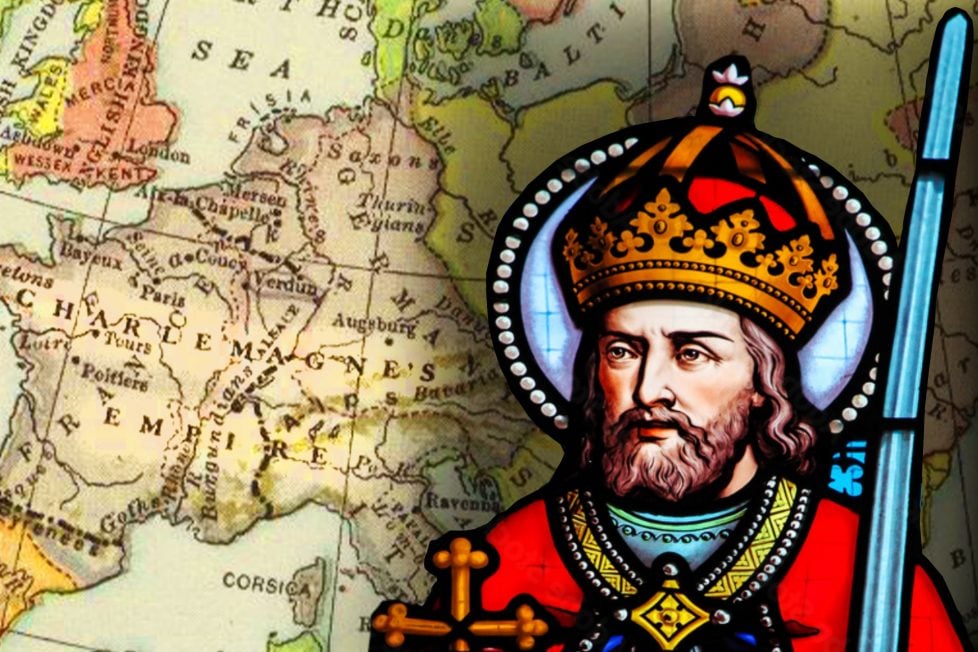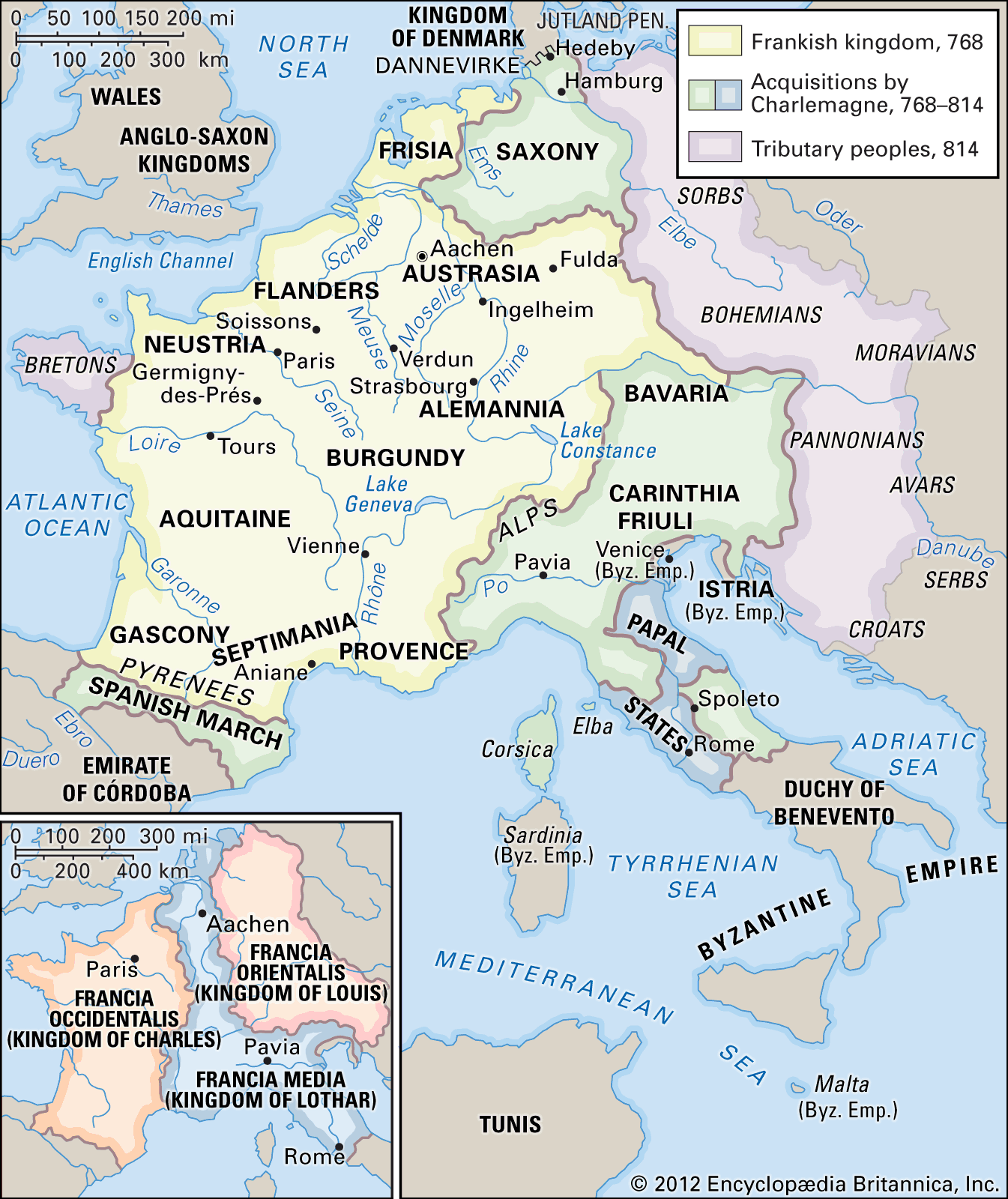Charlemagne: The Greatest Conqueror of the Middle Ages?
Charlemagne—unifier of Europe, protector of Christianity, and the first emperor of the Carolingian dynasty.

Charlemagne—unifier of Europe, protector of Christianity, and the first emperor of the Carolingian dynasty.

Table of Contents
ToggleThroughout the history of humankind, many great rulers and conquerors inspired respect, awe, and admiration. But what made them so great? Which among them stands out? One of the more obvious answers to that question is Charlemagne.
Charlemagne (born 747 – died 814), known as “Carolus Magnus” or “Charles the Great,” was a Frankish king and the Holy Roman emperor. Charlemagne was the son of Pepin the Short—the first ruler of the Carolingian dynasty. Building on the policies of his predecessors, Charlemagne continued the territorial expansion of the Frankish kingdom and the promotion of Christianity, but with much greater success.
His personal biographer and court scholar Einhard, in the work “The Life of Charlemagne,” described him as a large and strong man who enjoyed physical exertion, especially hunting, riding and swimming. Einhard also observed that Charlemagne had an unbridled appetite both for food and in his relationships with women. He was intellectually curious, spoke Latin and Greek and enjoyed the company of learned people, but in a seeming contradiction, he was illiterate.
Initially, he co-ruled with his brother Carloman, but took on sole leadership after Carloman’s death. As a ruler, Charlemagne led many successful campaigns against Arabs, Saxons, Avars, Lombards, Slavs, Normans, and others. He participated in more than 30 military campaigns across Europe.
Owing to his military and political triumphs, many historians view Charlemagne as the most accomplished medieval ruler and conqueror, having unified several diverse regions under his reign. Conversely, the eventual dissolution of his state has led some to argue that its foundational bonds weren’t robust enough, suggesting that perhaps Charlemagne’s acclaim might be overstated.
In this article, we will examine the facts and determine whether Charlemagne truly was the greatest medieval conqueror.

Like many great rulers, Charlemagne had to walk a difficult path in life. His father, Pepin the Short, died in 768. Before his death, in the tradition of the preceding Merovingian kings, he divided the Frankish Kingdom among his sons. The elder son, Charlemagne, received the northwestern parts of the kingdom (Austrasia, northern Neustria and most of Aquitaine). Pepin’s other son, Carloman, received the southeastern parts of the country (southern Neustria, Burgundy, Thuringia, Provence, Alsace and Alemannia, Thuringia, and some other areas).
There was no harmony between the brothers, especially when it came to foreign policy. In addition, their mother, Bertrada, who intended to lead foreign policy instead of her sons, stood in the way of Charlemagne’s sole rule over the kingdom. Both his mother and brother presented themselves as obstacles to that goal. Conveniently for Charlemagne, Carloman died at the end of 771, and Charlemagne, disregarding the inheritance rights of Carloman’s sons, seized all of his lands.
Now, with the path clear, Charlemagne’s rule became uncontested. And what kind of a ruler was he? By all measures, a great one! During his reign, the Frankish state reached its peak and occupied territories stretching from the North Sea to the Mediterranean and from the Pyrenees to Pannonia. No Western European state was as expansive in the Middle Ages.

You might assume that Charlemagne had little trouble conquering areas bordering his kingdom. He would simply need to raise his army, face his opponents, seize their lands, and annex them to his domain, right? However, in the Middle Ages, particularly during this era, conquest was no simple feat. Yet, Charlemagne did not shy away from a challenge. He recognized that to become the foremost king in Europe, he had to expand in every direction.
The wars fought during Charlemagne’s reign could be divided into five main areas: Brittany, Italy, southern Aquitaine, Pannonia and the areas bordering the Saxons and Slavs.
From the outset of his reign, Charlemagne embarked on military campaigns. Heeding the Pope’s call for assistance against the Lombards, he defeated them in several wars, thereby assuring the security of the Papal State. Subsequently, he declared himself “King of the Franks and Lombards.”
Yet, the campaign that truly defined Charlemagne’s reign was the protracted series of wars against the Saxons. This conflict spanned 32 years, from 772 to 804. Among all the wars the Franks engaged in, none were more enduring, costly, or fierce. The Saxons, who occupied vast lands in what is today’s Germany, mounted formidable resistance. This campaign initiated the Frankish state’s expansion eastward. Charlemagne’s conquest of Saxony and the annexation of Bavaria brought the Franks in contact with several neighboring peoples.

At the time of Charlemagne’s reign, Slovenian tribes lived along the Elbe river and to the east of it. The subjugation of Saxony forced Charlemagne to take measures to protect his new border from the attacks of the Slavs. In 789, he attacked the Slavic tribes, devastated their land and forced them to recognize his authority.
At the same time, in the steppes of today’s Hungary, in Pannonia, lived the semi-nomadic Avarian tribes. They occasionally launched attacks on the neighboring areas of the Frankish state. Charlemagne, taking advantage of the internal struggle among the Avars, invaded their country and conquered a part of it. From the territory conquered in Pannonia, a buffer zone called the March of Pannonia was formed. These conquests made Charlemagne the ruler of many nations, roughly doubling the size of the Frankish state during his reign.
The only military campaign undertaken by Charlemagne that was entirely unsuccessful was an attack on Arab-controlled Spain in 778. By 781, Charlemagne solidified control over Aquitaine, establishing it as a subjugate kingdom on the border with Spain. In 788, the Emir of Cordova declared a holy war, sending Arab troops on an invasion of Aquitaine. Subsequently in 796, Charlemagne, in a counter effort, began an offensive against Muslim Spain, which led to the conquest of Spanish territory up to the Ebro River and the establishment of the Spanish March.

Conquest successes and the spread of Christianity strengthened the already good relations between Charlemagne and the papacy. In 799, Pope Leo III asked Charlemagne to help him against the rebellious nobility in Rome. The king’s reaction was swift and decisive because the military unit Charlemagne sent to Rome very quickly broke the resistance and arrested the Pope’s opponents.
The culmination of these good relations between the Pope and Charlemagne happened in 800 on Christmas Day, in the Basilica of St. Peter’s in Rome, when Pope Leo III crowned Charlemagne emperor. As he placed the crown upon Charlemagne’s head, he declared him the “Emperor of the Romans.” The official royal annals of the Franks describe this event as unexpected, suggesting Charlemagne was unaware, and perhaps even resistant. Just as Charlemagne concluded his prayer and prepared to rise from his knees, the Pope approached, placing “some kind of crown” on him. The assembly hailed him thrice as Augustus and the Emperor of the Romans. The Pope, then, prostrated himself before him, according to the ritual introduced by Diocletian.
The proclamation of Charlemagne as emperor had a symbolic meaning because it eliminated the possibility of subjecting Western Europe to the Eastern Roman Empire, it also marked the birth of Europe as a politically and culturally autonomous entity—a Western Community of Nations. This seemingly illegal act, undertaken by the Pope, met with strong opposition in the Eastern Roman Empire. Constantinople vehemently objected, as the Byzantine monarch viewed himself as the sole legitimate Roman Emperor. The prevailing belief then was that power in the West could only be vested by the authority of the Emperor of the Eastern Roman Empire. This tension culminated in a brief conflict and subsequent peace talks from 810 to 812 in Aix-la-Chapelle. Through this accord, the Byzantine Empire begrudgingly acknowledged Charlemagne’s imperial title—one of the biggest signs of Charlemagne’s greatness.

The concept of Charlemagne as the “father of Europe” has roots tracing back to his era. Charlemagne’s vast empire, which at its height encompassed modern-day France, Germany, and much of Italy, became synonymous with Europe after 1945. At this time, former adversaries sought to forge alliances, and the dream of European economic unity and political cohesion began to take shape.
Charlemagne’s administrative heart was his court in Aix-la-Chapelle. The entire realm was segmented into smaller units, known as counties or marches, overseen by administrators called margraves.
In Charlemagne’s era, the kingdom thrived. Through his reforms and leadership style, he created a robust and dominant state that spread its influence across Europe. Historical accounts laud Charlemagne as an extremely capable and benevolent ruler who successfully allied with the Church, a powerful institution of that age. This alliance culminated in his ceremonial crowning as the emperor of the Roman Empire. He was a supporter of his empire’s cultural advancement. Under his rule, Europe experienced a brief resurgence in art, culture, science, and an awakening of classical artistic values. This period is known as the “Carolingian Renaissance.”

Charlemagne, by then aged and ailing, died on January 28, 814, and was interred the same day in his palace chapel. His passing marked a pivotal moment in European history. Subsequent to this event, progress stalled, and the Frankish Empire began its gradual decline. Its pan-European dominance came to an end following the empire’s partition at Verdun in 843.

Ultimately, it’s fair to say that Charlemagne embodied the archetype of the European Middle Ages and remains its most distinguished conqueror.
